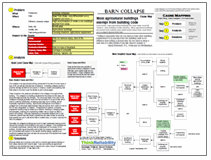A tragic accident devastated the Canadian town of Lac-Mégantic, Quebec on July 6, 2013. Much about the issue is still unknown. When investigating an incident such as this, it can be helpful to identify what is known and information that still needs to be determined.
What is known: a 73-car train was parked in Nantes, Quebec, uphill from Lac-Mégantic. Of the cars, 72 contained crude oil. The train was left unattended and late the evening of July 5, 2013, a fire broke out in the locomotive. While the fire department of Nantes was putting out the fire, they turned off the train’s main engine. Less than two hours later, the train rolled down the track and derailed in Lac-Mégantic. After subsequent explosions and long-burning fires, 24 people have been confirmed dead. 26 more are missing. Much of the town and the train – and the evidence in it – is destroyed.
What is not known: The cause of the initial fire on the train is not known. Whether or not the fire department should have explicitly notified the train engineer that the main engine had been shut off is not known. What happened that allowed the train to roll downhill is unknown.
With this number of unknowns, it is helpful to visually lay out the cause-and-effect relationships that occurred, and what impact they had on those affected. This can allow us to see the holes in our analysis and identify where more evidence is needed. Once as much evidence as possible has been obtained, additional detail can be added to the cause-and-effect relationships. Ensuring that all causes related to the incident are included will provide the largest number of solutions, allowing us to choose the most effective. We can do all this in a Cause Map, or visual root cause analysis.
The first step in using any problem solving methodology is to determine the impact caused by the incident. In this case, the deaths (and assumed deaths) are our most significant impact. Also addressed should be the crude oil leakage (though much of it was likely burned off), the high potential for lawsuits, the possible impact on rail shipments, the destruction of the town and the train, and the response and cleanup efforts. These form the initial “effects” for our cause-and-effect analysis.
Asking “Why” questions allows us to further develop the cause-and-effect relationships. We know that for the train to roll backwards down the hill, both sets of brakes had to be ineffective. The railway company has stated that the air brakes released because the main engine had been shutdown. However, according to the New York Times, “since the 19th century, railways in North America have used an air-braking system that applies, rather than releases, freight car brakes as a safety measure when it loses pressure.” This certainly makes more sense than having brakes be dependent on engine power.
The hand brakes functioned as backup brakes. The number of cars (which, when on a hill, affects the force pulling on the train) determines the number of handbrakes required. In this case, the engineer claims to have set 11 handbrakes, but the rail company has now stated that they no longer believe this. No other information – or evidence that could help demonstrate what happened to either sets of brakes – has been released.
Also of concern are the style of train cars – believed to be the same that the NTSB identified in a report on a previous train accident as “subject to damage and catastrophic loss of hazardous materials”.
In a tragedy such as this one, the first priority is to save and preserve human lives in every way possible. However, once that mission is complete, evidence-gathering to determine what happened is the next priority. As evidence becomes available it is added directly to the Cause Map, below the cause it supports or refutes. Additional causes are added as necessary with the goal of determining all the cause-and-effect relationships to provide the largest supply of possible solutions to choose from.
The company involved has already stated it will no longer leave trains unattended. That should be a big help but, given the consequences of this event, other solutions should be considered as well.
To view the Outline and Cause Map, please click “Download PDF” above. Or click here to read more.




